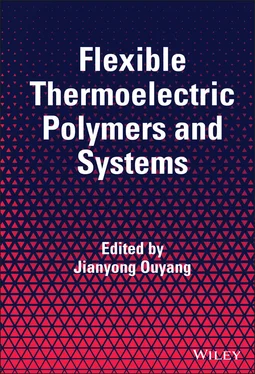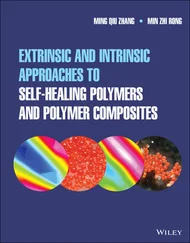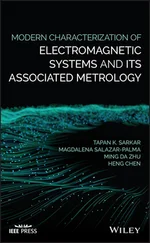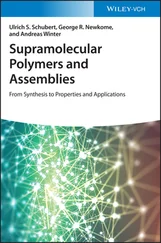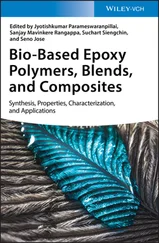Flexible Thermoelectric Polymers and Systems
Здесь есть возможность читать онлайн «Flexible Thermoelectric Polymers and Systems» — ознакомительный отрывок электронной книги совершенно бесплатно, а после прочтения отрывка купить полную версию. В некоторых случаях можно слушать аудио, скачать через торрент в формате fb2 и присутствует краткое содержание. Жанр: unrecognised, на английском языке. Описание произведения, (предисловие) а так же отзывы посетителей доступны на портале библиотеки ЛибКат.
- Название:Flexible Thermoelectric Polymers and Systems
- Автор:
- Жанр:
- Год:неизвестен
- ISBN:нет данных
- Рейтинг книги:3 / 5. Голосов: 1
-
Избранное:Добавить в избранное
- Отзывы:
-
Ваша оценка:
- 60
- 1
- 2
- 3
- 4
- 5
Flexible Thermoelectric Polymers and Systems: краткое содержание, описание и аннотация
Предлагаем к чтению аннотацию, описание, краткое содержание или предисловие (зависит от того, что написал сам автор книги «Flexible Thermoelectric Polymers and Systems»). Если вы не нашли необходимую информацию о книге — напишите в комментариях, мы постараемся отыскать её.
Comprehensive review of the rapidly evolving field of flexible thermoelectric polymers Flexible Thermoelectric Polymers and Systems
Flexible Thermoelectric Polymers and Systems
Flexible Thermoelectric Polymers and Systems — читать онлайн ознакомительный отрывок
Ниже представлен текст книги, разбитый по страницам. Система сохранения места последней прочитанной страницы, позволяет с удобством читать онлайн бесплатно книгу «Flexible Thermoelectric Polymers and Systems», без необходимости каждый раз заново искать на чём Вы остановились. Поставьте закладку, и сможете в любой момент перейти на страницу, на которой закончили чтение.
Интервал:
Закладка:
Table of Contents
1 Cover
2 Title Page
3 Copyright Page
4 List of Contributors
5 Preface
6 1 Fundamental Knowledge on Thermoelectric Materials 1.1 Properties of Thermoelectric Materials 1.2 Thermoelectric Generators 1.3 Peltier Cooling 1.4 Thermoelectric Sensors 1.5 Summary Acknowledgment References
7 2 Conductive Polymers for Flexible Thermoelectric Systems 2.1 Introduction 2.2 Chemical Design and Synthesis of Conductive Polymers 2.3 Doping of Conductive Polymers 2.4 The Properties of Poly(3,4‐ethylenedioxythiophene) 2.5 Processing Technics for Flexible Thermoelectric Generators 2.6 Conclusions and Perspectives Acknowledgments References
8 3 Flexible Thermoelectrics Based on Poly(3,4‐Ethylenedioxythiophene) 3.1 Introduction 3.2 TE Materials and Devices 3.3 PEDOT‐Based Flexible TE Materials 3.4 PEDOT:PSS‐Based TEGs 3.5 Conclusions and Perspectives Acknowledgments Conflict of Interests References
9 4 Flexible Thermoelectric Plastic Via Electrochemistry 4.1 Introduction 4.2 Electrochemical Deposition of CPs 4.3 Electronic Structure and Optical Properties 4.4 Electrochemical Doping and De‐doping 4.5 Thermoelectric Performance of Flexible CP Films 4.6 Control in Thermoelectric Performance by Electrochemistry 4.7 Conclusions Acknowledgments References
10 5 Thermoelectric Properties of Conducting Polymers with Ionic Conductors 5.1 Introduction 5.2 Mixed Ionic‐Electronic Conductors 5.3 Ionic Conductor/Conducting Polymer Heterostructures 5.4 High‐Performance Ion‐Conducting TE Polymers 5.5 Applications of Electronic–Ionic Coupled TE Organics 5.6 Summary Acknowledgments References
11 6 Thermoelectric Properties of Carbon Nanomaterials/Polymer Composites 6.1 Introduction 6.2 Conducting Polymers 6.3 Non‐Conducting Polymers 6.4 Ternary Thermoelectric Material 6.5 Summary and Outlook References
12 7 Low‐dimensional Thermoelectric Materials 7.1 Introduction 7.2 Zero‐Dimensional (0D) Inorganic Semiconducting Nanocrystals 7.3 One‐Dimensional (1D) Thermoelectric Materials 7.4 Two‐Dimensional (2D) Thermoelectric Materials References
13 Index
14 End User License Agreement
List of Tables
1 Chapter 1 Table 1.1 Seebeck coefficient of some metals, semiconductors, flexible mate...
2 Chapter 2Table 2.1 The properties of commercial PEDOT:PSS dispersons in water.
3 Chapter 3Table 3.1 Summary of TE properties of flexible PEDOT‐based composites.Table 3.2 PEDOT‐based TEG flexible devices and their performances.
4 Chapter 5Table 5.1 Chemical structures and charge carriers in typical a pure electro...Table 5.2 TE properties of several representative ion‐conducting polymers.
5 Chapter 6Table 6.1 Summary of thermoelectric properties of carbon material/PEDOT:PSS ...Table 6.2 Summary of thermoelectric properties of PANI‐based composite films...Table 6.3 Summary of thermoelectric properties of TE composites using PPy or...Table 6.4 Summary of the TE properties of non‐conducting polymer composites ...
6 Chapter 7Table 7.1 Experimentally measured σ , S , PF, μ and k values for 1D...Table 7.2 Lattice thermal conductivity and contribution of the acoustic phon...
List of Illustrations
1 Chapter 1 Figure 1.1 Band structures of (a) conductors, (b) semiconductors, and (c) in... Figure 1.2 Chemical structures of some representative conducting polymers: (... Figure 1.3 (a) A metal with different temperatures at the two sides. (b) Vol... Figure 1.4 Band structure of an n ‐type semiconductor. VB and CB are for the ... Figure 1.5 Dependence of the Seebeck coefficient, electrical conductivity, a... Figure 1.6 Dependences of the electrical conductivity, Seebeck coefficient, ... Figure 1.7 (a) Conductivity, (b) Seebeck coefficient, and (c) power factor o... Figure 1.8 Band structures of (a) intrinsic, (b) n ‐type, and (c) p ‐type semi... Figure 1.9 Polyacetylene (PA) with (a) a positive soliton and (b) a negative... Figure 1.10 Structures of polyactylene in (a) neutral state, (b) low doping ... Figure 1.11 Polythiophene with (a) a polaron and (b) a bipolaron. Figure 1.12 Band structures of conducting polymers with less symmetry in (a)... Figure 1.13 (a) Intrachain, (b) interchain, and (c) inter‐domain charge tran... Figure 1.14 UV–visible–NIR absorption spectra of PANi:HCSA films casted from... Figure 1.15 Conductivity of PEDOT:PSS after secondary doping with H 2SO 4. Figure 1.16 Temperature dependence of the resistance of a PEDOT:PSS treated ... Figure 1.17 Structures of a composite with two phases of α and β ... Figure 1.18 Dependence of thermoelectric generation efficiency on the temper... Figure 1.19 Schematic structure of a thermoelectric module with n ‐type and p Figure 1.20 Steady temperature and voltage profiles of a thermoelectric leg ... Figure 1.21 Scheme of the different heat fluxes of an n ‐type thermoelectric ... Figure 1.22 (a) A thermoelectric generator with n ‐ and p ‐type legs. Heat tra... Figure 1.23 Variations of the power output of a TEG with the load resistance... Figure 1.24 Schematic illustration of thermoelectric cooling. An external el...
2 Chapter 2 Figure 2.1 (a) Representative chemical structures of common conductive polym...Figure 2.2 The structures of some widely used donor and acceptor fragments....Figure 2.3 (a) Mechanism of the organic semiconductor doping process. (b) Re...Figure 2.4 (a) The schematic diagram of transfer printing PH1000 electrode. ...Figure 2.5 (a) Seebeck coefficient, electrical conductivity, and (b) power f...Figure 2.6 Schematic of (a) doctor blade coating, (b) screen printing, and (...
3 Chapter 3Scheme 3.1 Chemical structure of PEDOT:PSS.Figure 3.1 Typical flexible TE device configuration showing multiple alterna...Figure 3.2 Flexible TE thin films with PEDOT:PSS as p‐type legs and ITO‐dope...Figure 3.3 (a) Configuration of Te‐PEDOT:PSS‐based TE devices on flexible su...Figure 3.4 (a) Photos of PEDOT:PSS‐coated paper prepared by Zhang et al....Figure 3.5 (a) Preparation of PEDOT:PSS/PVA/Bi 0.5Sb 1.5Te 3composite films by...Figure 3.6 (a) Preparation of SnSe 1−xTe xnanosheets. (b) Preparation o...Figure 3.7 (a) Preparation and photos of PEDOT:PSS/SWCNT composite films by ...Figure 3.8 (a) Preparation of PEDOT/a‐SWCNT composite materials. (b) Photos ...Figure 3.9 Configuration of five PEDOT:PSS films connected by silver electro...Figure 3.10 (a) Roll‐to‐roll printing of p‐ and n‐type strips as well as the...Figure 3.11 Schematic illustration of a stencil‐printing method as well as s...Figure 3.12 Schematic illustration of the final TEG device on knitted fabric...Figure 3.13 (Left) PEDOT:PSS and PEDOT:PSS doped with V 2O 5device connected ...Figure 3.14 (a) Schematic showing p‐type legs (PEDOT:PSS) and n‐type legs (T...Figure 3.15 (a) Schematic of free standing PEDOT:PSS (b) output power densit...
4 Chapter 4Scheme 4.1 Classical formation mechanism of electrochemical polymerization f...Figure 4.1 Free‐standing conductive plastic obtained by electrochemistry. (a...Figure 4.2 Illustration of the principle of measurement for the HOMO and LUM...Figure 4.3 Schematic showing (a) Formation of polaron, bipolaron, and bipola...Scheme 4.2 Illustration for p‐doping in PEDOT with their chemical and band s...Figure 4.4 Temperature dependence of the electrical conductivity (a), the Se...Figure 4.5 (a) Electrical conductivity and the Seebeck coefficient as well a...Figure 4.6 (a) Electrical conductivity and the Seebeck coefficient with (b) ...
5 Chapter 5Figure 5.1 Classes of organic MIECs. (a–c) MIECs categorized between heterog...Figure 5.2 TE properties of MIECs. Comparisons of (a) electrical conductivit...Figure 5.3 TE properties of ionic conductor/conducting polymer heterostructu...Figure 5.4 In‐situ Raman spectra of the ionic conductor/conducting polymer h...Figure 5.5 Ultrahigh Seebeck coefficient of cellulose ionic conductors and t...Figure 5.6 TE properties and FT‐IR spectra of ionogels. (a) Chemical structu...Figure 5.7 Applications of the IL/PEDOT:PSS heterostructure and EMIM‐TFSI/PV...Figure 5.8 Working principal of an ionic capacitor and a comparison of conve...Figure 5.9 Application of a MIEC aerogel as pressure–temperature‐humidity mu...
Читать дальшеИнтервал:
Закладка:
Похожие книги на «Flexible Thermoelectric Polymers and Systems»
Представляем Вашему вниманию похожие книги на «Flexible Thermoelectric Polymers and Systems» списком для выбора. Мы отобрали схожую по названию и смыслу литературу в надежде предоставить читателям больше вариантов отыскать новые, интересные, ещё непрочитанные произведения.
Обсуждение, отзывы о книге «Flexible Thermoelectric Polymers and Systems» и просто собственные мнения читателей. Оставьте ваши комментарии, напишите, что Вы думаете о произведении, его смысле или главных героях. Укажите что конкретно понравилось, а что нет, и почему Вы так считаете.
